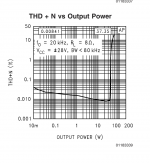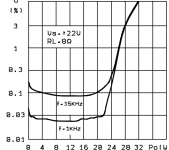85dB/2.83V @ 1m, 8ohms speakers will give a nearfield (@ 1m, sitting at a computer screen, maybe) will give ~88dB from the pair when each is fed with 1W from a pair of power amplifiers.Assume an average listening level of 80dB with a headroom of 20dB for peaks, you need to build in some more reserve. I do not believe 20W is enough for a nearfield system except in the most undemanding situations.
20W+20W will give around 98dB @ the 1m nearfield listening position.
If that is the peak level and your average level is -20dB ref maximum, then you have a nearfield average listening level of around 78dB.
That is above conversation level!
20W+20W and 85dB speakers are just fine.
90dB speakers is plenty loud enough for very dynamic audio files.
20W+20W and 85dB speakers are just fine.
All '20W' amplifiers are not created equal....
Attachments
The left diagram is showing a maximum 20kHz power of ~40W into 8r0 @ ~0.1% THD+N
The right diagram is showing a maximum 15kHz power of 20W into 8ro @ ~0.1% (THD and THD+N not specified) and increasing to 23.5W when the frequency is 1kHz.
These two amplifiers are not claimed to be equal !
What is the point you are making?
The right diagram is showing a maximum 15kHz power of 20W into 8ro @ ~0.1% (THD and THD+N not specified) and increasing to 23.5W when the frequency is 1kHz.
These two amplifiers are not claimed to be equal !
What is the point you are making?
They are not equal in terms of the chip, nobody said that.
My point is exactly that: both are not equal.
My point is that at 20W, each amplifier will behave differently. Some will be more linear than others.
My point is that the chip determines the linearity (or otherwise) of the overall amplifier.
My point is that one should choose the most linear method possible. Specially since the system is for nearfield listening. The absence of room effects makes other forms of noise and distortion much more apparent. You won't even begin to believe how much noise and crud can be heard through speakers close up, even with very quiet amplification. Ask a sound engineer.
My point is there are many ways to choose a system. Only considering the maximum possible electrical output is one of them, but not the only one. I believe there is a better way. For me, at least.
My point is exactly that: both are not equal.
My point is that at 20W, each amplifier will behave differently. Some will be more linear than others.
My point is that the chip determines the linearity (or otherwise) of the overall amplifier.
My point is that one should choose the most linear method possible. Specially since the system is for nearfield listening. The absence of room effects makes other forms of noise and distortion much more apparent. You won't even begin to believe how much noise and crud can be heard through speakers close up, even with very quiet amplification. Ask a sound engineer.
My point is there are many ways to choose a system. Only considering the maximum possible electrical output is one of them, but not the only one. I believe there is a better way. For me, at least.
Thanks for all the replies.
I am aiming to achieve 90dB at 1m as that is what is on the specification sheet that I gave in to my teacher. As long as I achieve 90dB at 1m I will get full marks as that is what I have stated I want to able to produce.
I can easily afford to go up to 100dB to accommodate for peaks, however would this make the process any more difficult for me?
I am guessing instead of a 2W amplifier I would need around about a 20W amplifier to produce 100dB. Would this mean I would have to use potentiometers to control the output power?
I am aiming to achieve 90dB at 1m as that is what is on the specification sheet that I gave in to my teacher. As long as I achieve 90dB at 1m I will get full marks as that is what I have stated I want to able to produce.
I can easily afford to go up to 100dB to accommodate for peaks, however would this make the process any more difficult for me?
I am guessing instead of a 2W amplifier I would need around about a 20W amplifier to produce 100dB. Would this mean I would have to use potentiometers to control the output power?
Use volume potentiometers to control the input signal. Not the output signal.
The output signal is a constant factor (gain) times the input signal.
If you use 80dB/W @ 1m speaker/s and input 1W you get 80dB @ 1m in their passband.
90dB requires 10 times more power, i.e. 10W into 80dB/W @ 1m speaker gives 90dB @ 1m (the difference between 80dB and 90dB is a ratio of 1:10)
There will be a little bit lost due to power compression, allow maybe 1dB to 2db. i.e. input power to the speaker needs to be ~ 1dB to 2dB more than the theoretical 10W that is predicted from the speaker specification.
The output signal is a constant factor (gain) times the input signal.
If you use 80dB/W @ 1m speaker/s and input 1W you get 80dB @ 1m in their passband.
90dB requires 10 times more power, i.e. 10W into 80dB/W @ 1m speaker gives 90dB @ 1m (the difference between 80dB and 90dB is a ratio of 1:10)
There will be a little bit lost due to power compression, allow maybe 1dB to 2db. i.e. input power to the speaker needs to be ~ 1dB to 2dB more than the theoretical 10W that is predicted from the speaker specification.
- Status
- This old topic is closed. If you want to reopen this topic, contact a moderator using the "Report Post" button.
- Home
- Amplifiers
- Chip Amps
- Chip amp for my power amp

